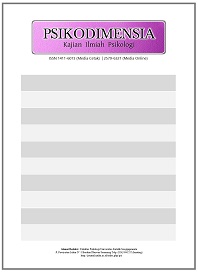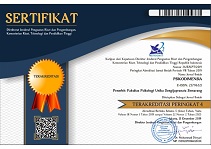FAKTOR-FAKTOR YANG MEMENGARUHI SIKAP TERHADAP LARANGAN MEROKOK PADA MAHASISWA
Abstract
baik bagi yang mengonsumsi secara langsung (perokok aktif) maupun
secara tidak langsung (perokok pasif). Berbagai gerakan yang mendukung
mengenai pengurangan rokok telah dilakukan oleh berbagai lembaga di
dunia, salah satunya Fakultas Psikologi Universitas Katolik Soegijapranata.
Penelitian ini merupakan studi deskriptif dengan tujuan memberikan
gambaran mengenai faktor-faktor yang memengaruhi sikap mahasiswa
terhadap larangan merokok. Penelitian ini menggunakan 100 orang sampel
yang tersebar dari tahun angkatan 2012 hingga 2015. Analisis data yang
digunakan adalah metode statistik nonparametrik terhadap delapan variabel
penelitian. Hasil penelitian menunjukkan bahwa faktor-faktor yang
signifikan memengaruhi sikap mahasiswa terhadap larangan merokok
adalah behavioral belief, jenis kelamin, orang lain yang dianggap penting,
status merokok dan niat untuk berhenti merokok. Sedangkan, kebudayaan
dan media massa tidak memengaruhi secara signifikan.
Keywords
Full Text:
PDFReferences
Ajzen, I., & Fishbein, M. (2005). The Influence of Attitudes on Behavior. Dalam D. Albarracin, B. T. Johnson, & M. P. Zanna (Penyunt.), The Handbook of Attitudes (hal. 173-221). Mahwah: Lawrence Erlbaum Associates.
Butler, K. M., Rayens, M. K., Hahn, E. J., Adkins, S. M., & Staten, R. R. (2011). Smoke-Free Policy and Alcohol Use Among Undergraduate College Students. Public Health Nursing, 29(3), 256-265. doi:10.1111/j.1525-1446.2011.01000.x
Chaaya, M., Alameddine, M., Nakkash, R., Afifi, R. A., Khalil, J., & & Nahhas, G. (2013). Students’ Attitude and Smoking Behaviour Following the Implementation of A University Smoke-free Policy: A Cross-sectional Study. BMJ Open, 3, 1-8. doi:10.1136/bmjopen- 2012-002100 Doucet, J. M., Velicer, W. F., & Laforge, R. G. (2007). Demographic Differences in Support for Smoking Policy Interventions. Addictive Behaviors, 32, 148-157. doi:10.1016/j.addbeh.2006.04.003
Finegan, B. A., & Finegan, G. J. (2011). From Discarded Leaf to Global Scourage – The Extraordinary History of the Ascent of Tobacco and its Many Modes of Consumption. Dalam D. Benhard (Penyunt.), Cigarette Smoke Toxicity: Linking Individual Chemical to Human Diseases (hal. 2). Weinheim: Wiley-VCH.
Gilpin, E. A., Lee, L., & Pierce, J. P. (2004). Changes in population attitudes about where smoking should not be allowed: California versus the rest of the USA. Tob Control, 13, 38-44. doi:10.1136/tc.2003.004739
Hong, Y. H., Soh, C. H., Khan, N., Abdullah, M. M., & Teh, B. H. (2013). Effectiveness of Anti- Smoking Advertising: The Roles of Message and Media. International Journal of Business and Management, 8(19), 55- 62. doi:10.5539/ijbm.v8n19p5 5
Murnaghan, D. A., Blanchard, C., Rodgers, W., Rosa, J. L., Macquarrie, C., Maclellan, D., & Gray, B. (2009, Oktober). The influence of student-level normative, control and behavioral beliefs on staying smokefree: An application of Ajzen’s theory of planned behavior. Addiction Research and Theory, 17(5), 469-480. doi:10.1080/16066350802011649
Rashid, A., Manan, A. A., Yahya, N., & Ibrahim, L. (2014, Oktober). The Support for Smoke Free Policy and How It Is Influenced by Tolerance to Smoking – Experience of a Developing Country. PLOS ONE, 9(10), 1-7. doi:10.1371/journal.pone.0109429
Rigotti, N. A., Regan, S., Moran, S. E., & Wechsler, H. (2003). Students’ Opinion of Tobacco Control Policies Recommended for US Colleges: A National Survey. Tobbaco Control, 12, 251-256. doi:10.1136/tc.12.3.251
Rosenberg, M., Pettigrew, S., Wood, L., Ferguson, R., & Houghton, S. (2012). Public Support for Tobacco Control Policy Extensions in Western Australia: a Cross-sectional Study. BMJ Open, 2(2), 1-8. doi:10.1136/bmjopen- 2011-000784
Simons-Morton, B., & Farhat, T. (2010). Recent Findings on Peer Group Influences on Adolescent Substance Use. The Journal of Primary Prevention, 31(4), 191- 208. doi:10.1007/s10935- 010-0220-x
Utami, M. S. (2007). Pregnancy and Giving Birth in Couples From Central- Java: Contributions From Psychology to Safe Motherhood. Nijmegen: Radboud University.
Widati, S. (2013). Efektivitas Pesan Bahaya Rokok Pada Bungkus Rokok Terhadap Perilaku Merokok Masyarakat Miskin. Jurnal Promkes, 1(2), 105-110.
World Health Organization. (2015). WHO Global Report on Trends in Prevalence of Tobacco Smoking 2015. Geneva: World Health Organization. Dipetik August 22, 2015, dari http://www.who.int
Yahya, A. F. (2010). Menaklukkan Pembunuh No. 1: Mencegah dan Mengatasi Penyakit Jantung Koronener Secara Cepat dan Tepat. Bandung: Qanita, PT Mizan Digital Publishing.
DOI: https://doi.org/10.24167/psiko.v15i2.992
Print ISSN : 1411-6073 | online ISSN : 2579-6321 View My Stats

This work is licensed under a Creative Commons Attribution 4.0 International License.




















